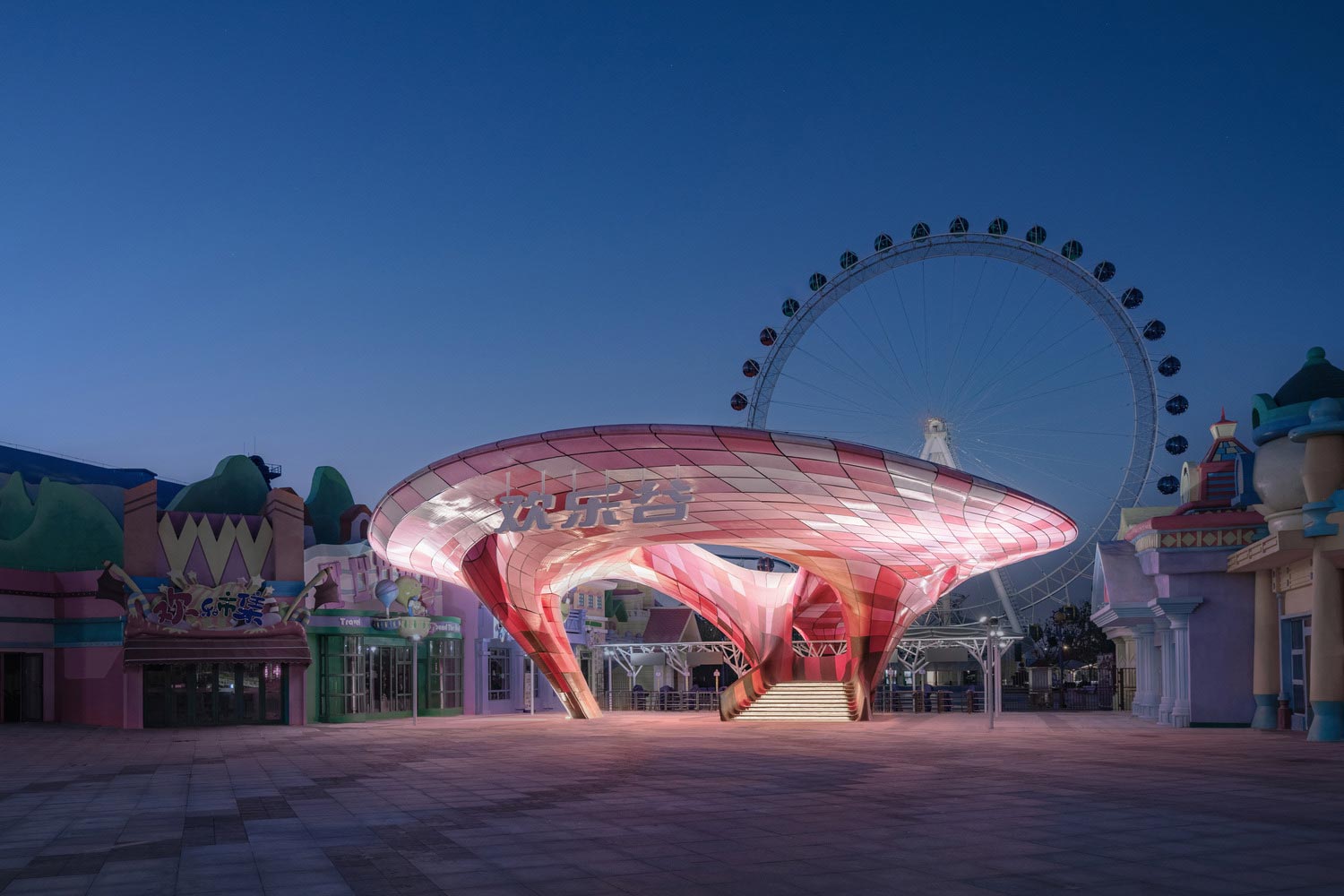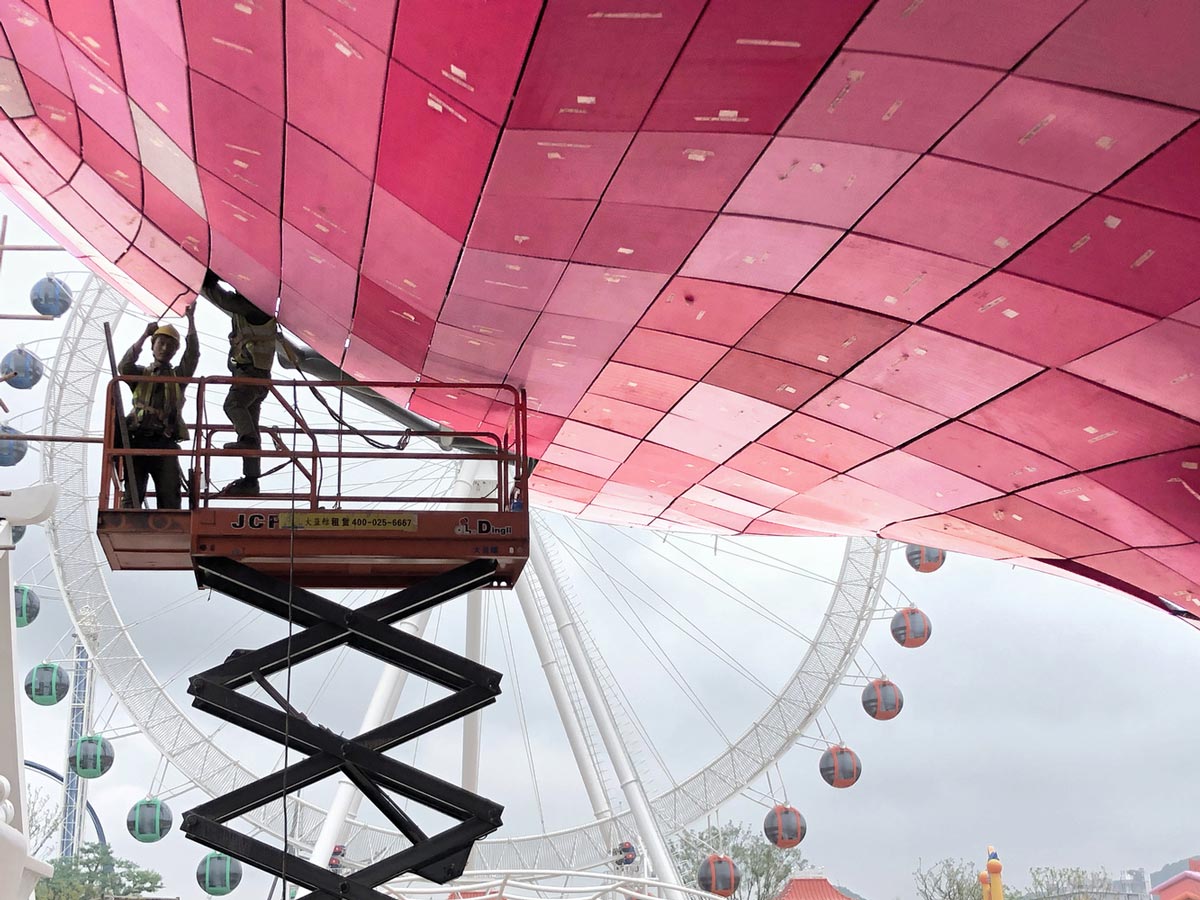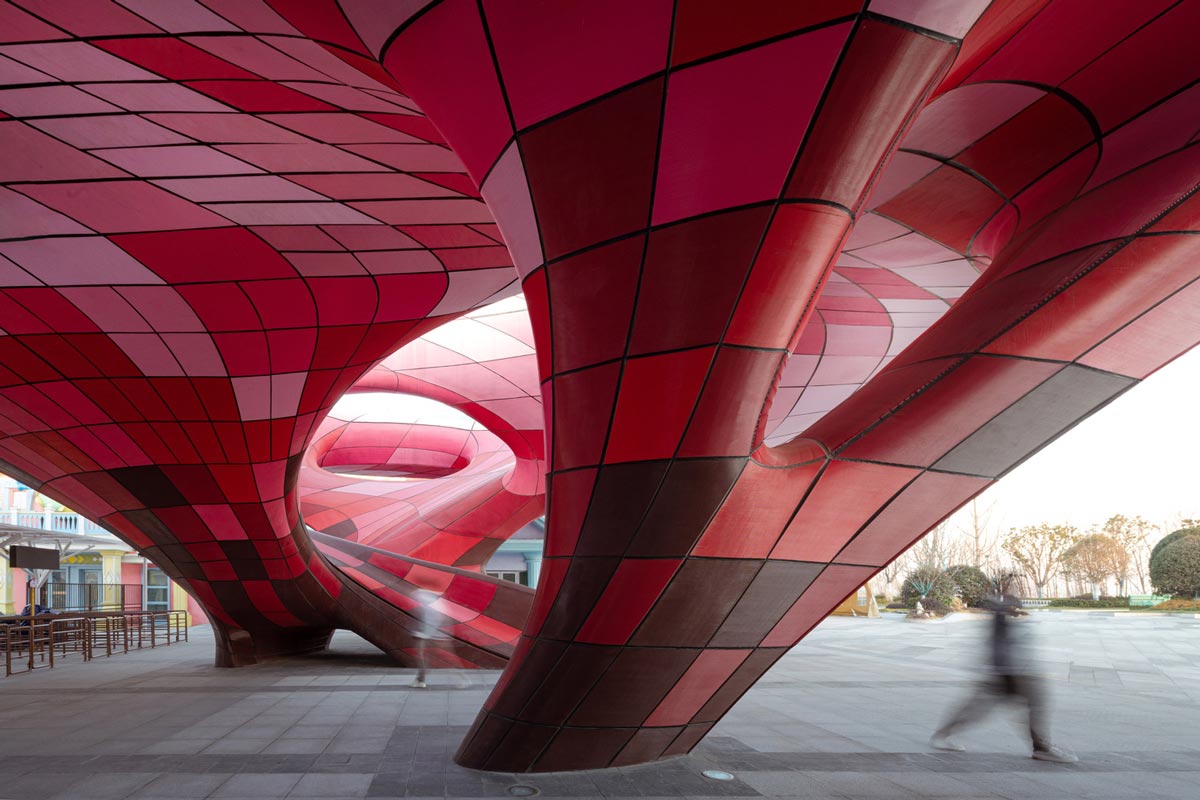Humans and robots are entering a new era. The world’s most extensive modified plastic 3D printed architecture, Nanjing Pavilion of Happy Valley Theme Park East Gate, designed by Archi-Union Architects and Fab Union, reminisces a step into another dimension. The park officially opened after six months of operation and observation due to COVID-19. The design reflects a beguiling avant-garde structure erect and fascinating as a futuristic marvel.
Human designers and robotics has sewn an innovative workflow reshaping the traditional design-build process. The super-scaled and high-dimensioned geometry envisioned with high efficiency and accuracy portrays the technical advancement of automatic printing. A uniquely customized form strives to present as a symbolic representation of Nanjing Happy Valley, functioning as a perfect transition for travellers through the front plaza to the theme park.
Stimulating circulation, perfectly organized in a joyful arena, intrigues us to ponder its use post epidemic era. How significant should a creation ensure an inviting and warming atmosphere while spatially managing the circulation of the entrance/exit?
The hyperbolic multi-layered surface sculpted using computational geometry stretches infinitely with porous penetration. The structure bends, curves and folds, racing the spatial experience as the forms weave to attenuate the boundary lines of the building: the pavilion presents a complete steel skeleton and modified plastic-printed construction system on a coloured outer surface covered with GRP panels.
The east gate extends 52-meters in length and 26-meters in width, projecting over 1352 square meters, and a surface unfolds of 1950 square meters. The heterogeneous irregular overhang span up to 30m, encountering and challenging the design and construction team. 18,300 square meters, the plaza stands as a significant padding and background, a transcendent and welcoming gate, inspiring to invoke a mesmerizing spatial experience for tourists and visitors alike.
The design concept embellishes the factors such as Flow, Form, and Field. The project envisions the east gate, the entrance plaza, and an underground gateway. Integrating elements from the site, the team’s research showcased unpredictable travelling routines of different users. The analysis showcased variations and intensities of crowd flow interference. To solve the crowding problem, they marked a swarm of particles moving in the site. Simulating the motion lines of a self-organizing particle in a swarm-based algorithm on a multi-agent cluster system. The different motion lines transform into vector elements as the crowd behaviour in the whole square procedures a complex random vector field. Besides that, several areas in the environment, such as vector direction field, vortex field, point field, repulsive force field, and centripetal force field.
The simulating systems can alter the environment in reality. During the simulation, the east and west entrances of the site and the square entrance are considered starting points of particle motion. The composite force field is regarded as the force field environment of the actual space. The influence of the hybrid force field on the trajectory of particle motion and the change in the spatial distribution of the particle population is obtained through computational analysis.
Analyzing the relationship between the crowd and site, the simulation results based on cluster intelligence and pixelated interference would transform the complexity between two fields into the textured layering of the plaza pavement and finalize the schematic spatial planning and organization of large-scale space in the surrounding area. The architectural form needs to align with comprehensive elements.
The entrance engages in complex pedestrian flow and various activities as many visitors pass through the ground level of the access. Inward extrusion of the building boundaries on both sides, as the entrance becomes a multi-dimensional topological geometry floating in the site.
The intelligence of design-based form generation reflects the collaboration between architects and computers, where computational geometric topological prototypes occur from mathematical surfaces. A simplified equation represents the dazzling calculation.
Through dynamic adjustment and final morphological results of input parameters a, b, c, d, e, g, the topological geometric prototype fulfils obtaining the design. The architect iterates derivates the geometric operation of the prototype viewing frame scenes and spatial accessibility.
The base mesh aids information to generate the built form. The generation of a mesh conforms to the boundary from the geometric parameters. The generation process covers the Boundary Input, Surface Skeletonization, Skeleton Subdivision, and Mesh steps. The final topological surface can be applied for actual construction.
In the gravity field effect, the preliminary form needs to be simulated for structural performance, optimization of support location, visual access, and mechanical stability, forming the final multi-point support system. The point and line feature the topological mesh to the structural support and force conditions. Hence, the geometric mesh generated based on the topological mesh is consistent with the form and allows the structural system to be incorporated into the parametric design.
The protruding staircase leads visitors to experience the spatial diversity of the curvaceous geometry at various levels and summoning ecstatic vistas. An unconventional geometric view frames a specific point of sight passing through the circular cutout in the geometry, reaching the Ferris wheel at the end of the axis of the park. All visitors from all directions can immerse themselves in the spatial relationship beyond geometry.
The design team developed a software platform as a paradigm innovation in contemporary architecture named FURobot. Translating the building language of modules and path process planning. An adaptive inverse deformation algorithm for local geometric models, solving continuous surfaces with unfolded areas up to 1950 meter square into more than 4,000 curved sheets for prefabrication in the factory. The printing paths are remotely generated, with one of the designer members operating from Malaysia during the epidemic. Human-robot communication makes it possible to fulfil the architect’s creativity and mass production customization in construction.
Six shades of pink were designed for each panel by the algorithm of coloured pixel collage. These coloured panels, as a metaphor, represent the variety of activities in the Happy Valley. The design induces the visitors with a welcoming gesture as a grand opening. After immense material testing and performance experiments, the team precisely developed an outdoor UV-resistant colour-modified plastic material, achieving 256 colours with precise parametric colour printing technology.
The self-developed FURobot software applied to the 3D program prints algorithms for each panel for machine recognition and real-time feedback. Each panel is prefabricated and printed by a robot in the factory and transported to the site for modular composite installation with a numbering system.
The cross-construction work on-site resulted in the great difficulty of spatial coordination for multi-dimensional topological forms. Building a site for digital construction, intelligent sensing and feedback system allows daily access to construction data, meanwhile brings assurance of dynamic prediction of installation accuracy and hybrid dimensions for intense construction periods.
The autonomous perception system of the digital site ensures the complex realization of multi-dimensional topology. The digital birth shape and construction complement each other. The entrance gate and the surrounding elements are coherent and integrated. Through the tweaking of scale and novel materials, the visitors complete the city’s transformation to the theme park’s state of mind at a gradual pace. The idea of transforming traditional ticketing into the prelude to start a wonderful journey, greatly enhancing the ticketing experience, transforms into a prelude to a fantastic trip, immensely improving the sense of anticipation and joy.
Safe breathing and healthy socializing will no longer be the central focus in the post-pandemic age; instead, the advanced technology and culture have evolved to tackle potential themes and explore. Under the global post-pandemic scenario, technology merging into traditions and culture might trigger reactivation in a post-humanism era. The entire exploration and design of Nanjing Pavilion initiate from the prototype, art exhibitions to mass productions on crucial groundwork. The project thus valued an important historical retrospective and social perspective.
Project Details
Architects: Archi-Union Architects
Photographs: Schran Image, Songkai Liu
Principal Architect: Philip F. Yuan, School of Architecture and Urban Planning (CAUP), Tongji University
Architecture Team Members: Weizhe Gao, Xiangping Kong, Teng Long
Digital Construction: Shanghai Fab-Union Intelligent Engineering Co. Ltd
Digital Construction Team Members:Li Han, Wen Zhang, Liming Zhang, Xuwei Wang, Zhewen Chen, Tao Yu
Structural Design: Xie Yimin Engineering Technology Co.
Lighting Design: Beirui Visual Art Design (Shanghai) Co.
Developer: Eastern Overseas Chinese Town Group (Nanjing) Co., Ltd
City: Nanjing
Country: China




































Leave a comment